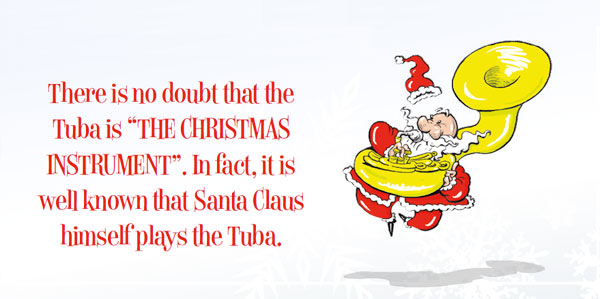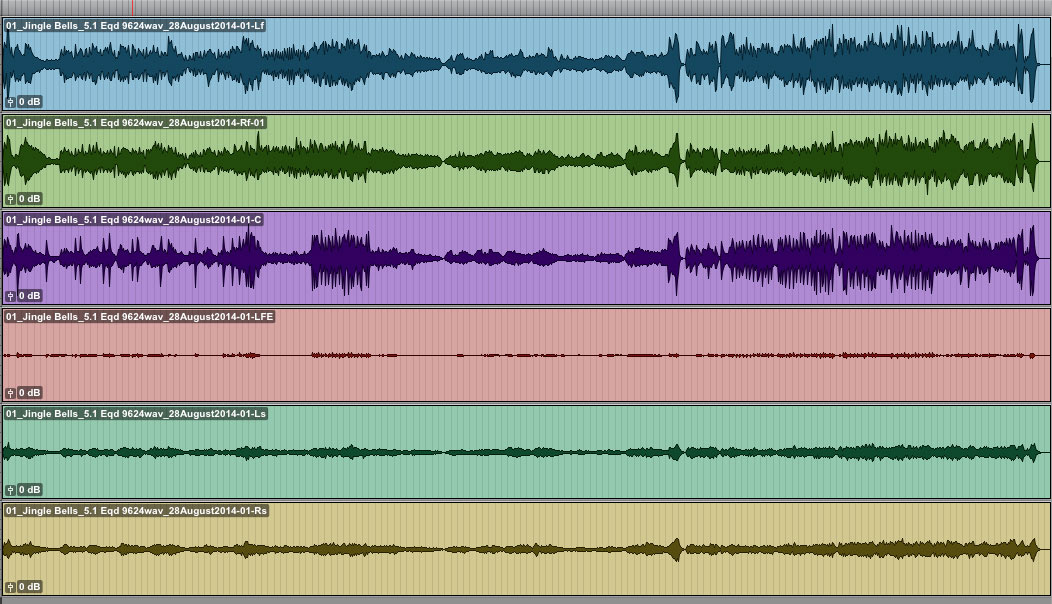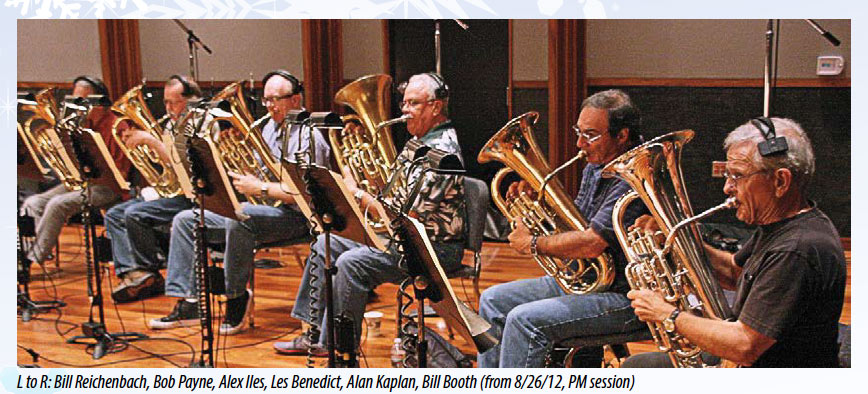Tubas, Christmas, & Interleaving 5.1 WAVs
I’m working getting a new Christmas release ready for iTrax. Scott Wilkinson, the Home Theater Geek who is a brass player himself, suggested that Jim Self contact me about making a high-resolution version of his, “‘Tis a Season Tuba Jolly” CD. As the name indicates, the project is a collection of Christmas tunes played by the lower members of the brass family. This includes tubas and euphoniums along with a drummer and percussion. Jim Self is probably THE “go to” guy when it comes to tuba players. He was the studio musician that played the very famous tuba solo at the end of Steven Spielberg’s “E.T.”.
So we chatted on the phone the other day about his project. He was unable to find a home for the high-resolution stereo and surround mixes that he and his engineer Shawn Murphy (a very well-know scoring mixer here in Los Angeles) produced over the past few years. I invited him over to the studio so that I could take a look at what he has, audition the surround mixes, and make a plan for moving the project forward. After wading through a bunch of folders on his hard drives, we were able to find the mastered 5.1 surround mixes of his 20 tunes.
Each song consisted of 6 individual WAV files at 96 kHz/24-bits. There was one for each of the channels in the surround speaker arrangement. Jingle_Bells_C, Jingle_Bell_LF, Jingle_Bells_LFE etc. Having discrete files is great for archiving purposes and for working in a DAW environment but they don’t work in my Oppo or any other consumer MCH music player that I know about. I had no problem pulling each of the files into a blank Pro Tools session and sending them to the appropriate output, but that not what consumers need or want.
Figure 1 – The Pro Tools session showing each of the discrete WAV files of the multichannel mix. [Click to enlarge]
I had to convert or “bounce out” each of the tunes to an interleaved multichannel WAV file. An interleaved file includes all of the individual channels interspersed with each other. The digital information contains a small “packet” of the Left Front channel, then a bit of the Right Front channel and so on until all of the channels have been touched and it goes around again. When you transfer the resultant file to a USB stick, it is now one file that is 6 times larger than the individual WAV files that you started with. But if you plug it into the front of your Oppo player and navigate to the interleaved file, it is playable as a fully immersive surround music file. The packets of individual channel data are collected in a data buffer and then synchronously output via the 6 DACs.
Unfortunately, it was a real time process to convert all of the discrete files to interleaved versions. But I QC’d the tunes as they were being converted and I enjoyed listening to some really terrific playing, interesting arrangements, and spirited music. This is very fun record. I should have it ready for downloading in about a week. I’ll check with Jim about putting up a couple of sample tracks on the FTP site.
Figure 2 – A photo of the recording session for “‘Tis the Season Tuba Jolly”. [Click to enlarge]
Then there was the question of the stereo mixes. Shawn and the mastering engineer knew that the first released version of the record was going to be a CD. That meant converting the original 96 kHz sampling rate to 88.2 and then ultimately to 44.1 with 16-bits during the mastering process. That meant that I didn’t have a high-resolution mastered version of the project. It’s time to think outside of the box.
I’ll talk about the solution…downmixing…tomorrow.




Hi Mark, I didn’t want to take up your time unless something changed. Well, something has changed. Sonos, the ‘Kleenex’ of wireless distributed audio and an equal name to Bose in the public’s consciousness, has announced plans to offer high-quality audio. So… whether or not they go 24/96 or upgrade all to 24/44.1, the median level of sound quality widely available is about to jump up considerably. My point? This means that hi-res is definitely not just for a small market as you have been self-servingly stating. Between Sony and Sonos, you have majors bringing home the bacon for all. Again, do you think Sonos would do this if their market surveys indicated that everyone out there is so deaf and just loves MP-3 so much there is no need to change? I wish you success in your work . But you have no place to hide now. I’m no Sonos devotee, but obviously someone besides me also thinks that good sound for the masses is more important than great sound for the few. You have consistently avoided stating your own priorities about this, but just as you have been “outing” Pono in carefully concealed negative terms, Sonos announcement now shows your stance to be inaccuirate as far as mass appeal of good sound goes. Again, if they hadn’t mistakenly called it hi-res, your technical harangue would now look more semantically based than logically based. Who could possibly object when such large -scale mass audio improvements are in the works. As far as confusing PR from Pono and others; how’s this? I am a Sonos dealer, and called them a couple of months ago asking if they had plans to go hi-res. AT THAT TIME, their response was a firm no. Well, so you mean two people called up and said they want better? I DOUBT IT. One way or the other, it is clear that the public can hear the difference and WILL pay for it . I hope that doesn’t throw you off the track (s), so to speak, to find out that there may actually be both mass interest and mass money out there for hi-res.I call this very good news, I hope you do too.
Craig, just I thought we had reached a sort of common ground on things relating to High-Resolution audio and master quality audio. You’ve been sucked into the misleading hype once again. Sonos may claim to offer “high-quality” audio but it isn’t going to offer REAL high-resoution audio. Are you possibly referring to the Deezer initiative. The way I heard it Deezer tried to move the goal line of high-resolution and got slapped down at the recent CEDIA event such that they have backed off. Maybe the wording is “high-quality”, which obviously means nothing. Sonos depends on the providers listed on their web page for the music that their hardware outputs…whether from streams (decided not high-resolution) or files or physical disc playback. And unless I’m missing something, none of their hardware is capable of playing real high-resolution. Moving to 44.1 kHz/24-bits isn’t high-resolution.
Contrary to your comment, I do want real high-resolution audio and better fidelity for everyone. However, providing the same old thing in a new marketing campaign and a new container doesn’t qualify as “sound quality jumping up considerably” or “large -scale mass audio improvements”. Most consumers won’t be able to tell the difference because there isn’t any. Do you really believe that you could tell the difference between a CD at 16-bits vs. 24-bits? I’d be happy to prepare the test files if you think you can.
Sony and Sonos are playing the spin game…it’s up to the content providers to make meaningful change in the fidelity of the files we listen to and that’s just not happening in large enough numbers. Maybe it will someday. That’s why Pono is pulling in 2,485,000 CD tracks for their Ponomusic website. Because there isn’t enough of the real thing.
I’m glad this is a feel good moment for you. But it doesn’t fundamentally change anything. In fact, it simply reinforces my core beliefs relating to high-resolution audio. It’s being co-opted by hardware companies to help them sell boxes plain and simple. When the software/productions start sounding better, then I’ll start to pay attention. “High-quality” audio is something we already have.
128 MP-3 is not high quality audio, and you keep selling the public short. Whether it’s true hi-res by spec or simply 44.1 w/improved mastering and transfer a la XRCD, the number of big music software/hardware outfits investing in audio upgrades is a clear indication that their marketing surveys disagree with your repeated statements re: inability to distinguish between 320kbps and anything better. We are totally cool on the subject of the definition of hi-res; my main query now is why you are so sure folks won’t hear and pay for a noticeable improvement when these large outfits have already made their bets, bets they wouldn’t make were they not confident of revenue increase from these improved sonic offerings .If the masses get better sound, your own sales will increase as a trickle-down factor, so I’d think that being optimistic about public reaction to upgraded audio standards would serve your own purposes better than the veiled pessimism and cynicism I keep picking up in your writings.
Where did I say the a 128 kbps MP3 file is High Quality Audio…I did say and let people compare for themselves that 320 kbps MP3 files is under most circumstances indistinguishable from a CD. The improved mastering that we’re both hoping for isn’t happening. It’s not happening for XRCD, K2 or any of the other mystery CD mastering schemes. The only way people will hear dramatic improvement is when the labels release stuff that is dramatically better…and they aren’t going to do that in mass quantities. The companies you refer to are just trying to get on the gravy train that is faux HRA.
If “Faux HRA” sounds much better than the public median audio quality up to now, isn’t that what really matters? I’m not taking sides or in bed w/ any given party, especially Sonos, because they have made it so easy to hear so-so audio that many folks will not do that bit of extra effort into music enjoyment ,To say that this upsets me would be a gross understatement.
I just want to see better sound for everyman to happen. I doubt folks will pay for upgraded quality if they do not in fact clearly perceive it; we will shortly be in a “test the waters” period, transition, whatever terms you wish, but it does look like streaming high grade audio will be the norm once we get through this period, down the road. That will be the ultimate combo of quality and convenience that the public wants, and they will eventually get it if not sooner.
Again, we have no discord re: what constitutes the HRA label. And it is reasonable to expect “Faux HRA” to move closer to true HRA over time. The very announcement by Sonos shows this. I’m just asking for more positivity, if even and only for the fact that the wind has definitely shifted in the right direction. Final destination? Neither I nor anyone else knows, but it does seem safe now to say it will be a better(sonic) place than we’ve been stuck on for far too long. Remember, just as CD matured, I-Pod came along and stole the light. Let’s not let something like that happen this time. You can help.
As with so many currents, maybe you should run a good hi-fi shop for 30 years and I will start and pioneer a high-resolution recording label; I’m sure that such a role swap would allow both of us to eliminate all disagreements about the near and long term significance of Hi-Res.
And how about those paragraph breaks! Thanks, Craig
Faux HRA doesn’t sount much better than what people are getting now…that’s exactly the problem. If the base line were actually getting moved by a substantial amount then I would be all in with you. Go back and check out the CD vs. 320 kbps MP3 comparison. Almost a thousand people downloaded it and the vast majority of those that responded back agreed that it was not possible to tell the difference OR that it required a very good system.
Doc,
The “Charlie-Foxtrot” that the Ponos & the like must have you completely frustrated in the total derailment of what hi-res audio is supposed to be. I applaud your efforts and tenacious work to set standards of what high resolution audio is. Your ideas are completely reasonable, rational, and very transparent with an added value of consumer protection. Without the guidelines you’ve proposed, even the small market share audiophiles can’t be sure they’re getting what they paid for. Without regarding provenance the practice of selling material as high resolution audio is at best, deceptive, and at face value theft, IMHO. If the masters had no dynamic range and badly executed, it’ll most always be crap & not many people will want it anyway. There are recordings that were brilliant analogue releases that even sounded good on cassette, or even 8-tracks back in the day, that stood out from the rest. Some even made bad stereos sound bearable. Those are the recordings we find ourselves buying over and over again. That’s where I see you differ from your colleagues in the industry. You don’t treat us like idiots, instead of rubber stamping everything “high-res”, provenance brings honesty, but equally important, value to discerning listeners. We are out there and willing to pay a premium for something that exceeds our expectations. To meet our expectations is a mistake after buying “digitally remastered” and the industry squeezed out a few more sheckles from our wallets and left us wary of the recording industry as a whole. Thanks for your perseverance in an industry lacking direction and apparently, ethical standards.
Thanks a lot…this business will survive and thrive if the labels and distributors lose the spin and hype and just give us what we want. Information and the best available masters…and new recordings with real fidelity. But there isn’t enough marketshare in it yet.
I guess we’ll just have to hear “Faux HRA” and see what it sounds like. Since I at this time still prefer physical media, it would be a mixed reaction here anyway; I think folks who get rid of large CD or vinyl collections are making a huge mistake, but I recognize that not all share my feeling.
And you are probably tired of kicking this back and forth w/me, I have no trouble understanding that.
So from this point, I would say that talk is indeed cheap, and that hearing is believing. Despite all the dirty inside details you have injected into this series of articles, it simply will be a question of what we hear from so-called Faux HRA compared to straight CD, and I don’t think anyone involved in this dialogue has done so yet. If evidently better, then applause. If not , for the masses HRA ship sinks quickly .
I too dislike the micro-categorization of the format, but OTH many of the best sounding CD’s are from analog tapes that were digitally mastered. I am also sure it would be entirely possible to make a ‘real; HRA recording that doers not engage the listener. A great many of the “audiophile recordings” ever done fit into this category. We shall see, and pretty soon too. Thanks as always.
Thanks Craig…we will see how this plays out.